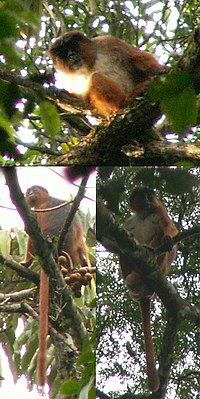Preuss colobus monkey
| Preuss colobus monkey | ||||||||||||
|---|---|---|---|---|---|---|---|---|---|---|---|---|

Preuss colobus monkey ( Piliocolobus preussi ) |
||||||||||||
| Systematics | ||||||||||||
|
||||||||||||
| Scientific name | ||||||||||||
| Piliocolobus preussi | ||||||||||||
| Matschie , 1900 |
The Preuss colobus monkey ( Piliocolobus preussi ) is a primate species from the group of colobus monkeys . It is sometimes listed as a subspecies of the Pennant colobus monkey , although the system within the genus of the red colobus monkey is controversial. The German zoologist Paul Matschie named the species in 1900 in honor of the botanist Paul Preuss , who, among other things, researched the flora of the former German colony of Cameroon.
features
Like all colobus monkeys, the Preuss colobus monkey is a slender animal with a long tail and receding thumb . Its fur is thicker with frizzy hair than the fur of other red colobus monkeys. The back and sides of the body are colored red-black, with black dominating the back and the reddish tint on the sides of the body. The groin , tail, the outside of the arms and legs, and the top of the hands and feet are orange to light reddish brown. The insides of the arms and legs are whitish. The abdomen, chest, throat and chin are light red gold. The front of the head, top of the head and neck are black, the cheeks are orange. Newborns are black with a gray belly side. The animals reach a head-trunk length of 56 to 63 cm and have a tail about 75 cm long. Information about the weight is not yet available. The females have a showy large clitoris and, during their fertility, develop a large, showy, rosy sexual lump that extends to the gluteal region and is the largest among the red colobus monkeys. Investigations of the mitochoindral DNA show that the Pennant colobus monkey ( Piliocolobus pennantii ) from the island of Bioko is the closest relative of the Preuss colobus monkey. The separation of the two species took place around 300,000 years ago. Outwardly, the species are very similar, but they differ significantly in their vocalizations.
distribution
These primates only live in western Cameroon in the Yabassi region (Ebo Wildlife Reserve and Makomba Forrest) and in Korup National Park and in the adjacent Oban sector in the Nigerian Cross River National Park. Their habitat is lowland rainforests undisturbed by humans. The species is absent in secondary forests .
Way of life
Little is known about their way of life, presumably it corresponds to that of the other red colobus monkeys. As a result, they are diurnal and mostly stay in trees. They live in large groups made up of several males and females and their offspring. So far, groups of 20 to more than 80 animals have been observed. A group inhabits a territory that is on average 100 hectares. Preuss colobus monkeys are herbivores that feed mainly on young leaves, as well as on fruits, shoots, flowers and beetles. Approximately 50% of the food plants of the species come from the families of the annone and sapote plants .
Danger
The main threat to the Prussian colobus monkey is human hunting. In the area around Korup National Park, the species makes up most of the bushmeat for sale . The natural predators that hunt down the Prussian colobus monkey include the chimpanzee , leopard , African golden cat , northern rock python and above all the crowned eagle . However, the vast majority of colobus monkeys that are killed fall victim to humans. In addition, the ongoing destruction of their habitat represents a threat to the animals. The International Union for Conservation of Nature ( IUCN) is now listing it as a critically endangered species, after the previous listings had read “Endangered”.
literature
- Thomas Geissmann : Comparative Primatology. Springer-Verlag, Berlin et al. 2003, ISBN 3-540-43645-6 .
- Don E. Wilson, DeeAnn M. Reeder (Eds.): Mammal Species of the World. A taxonomic and geographic Reference. Johns Hopkins University Press, Baltimore MD 2005, ISBN 0-8018-8221-4 .
Individual evidence
- ↑ a b c Elizabeth L. Gadsby, Colin P. Groves, Aoife Healy, K. Praveen Karanth, Sanjay Molur, Tilo Nadler, Matthew C. Richardson, Erin P. Riley, Anthony B. Rylands, Lori K. Sheeran, Nelson Ting , Janette Wallis, Siân S. Waters & Danielle J. Whittaker: Family Cercopithecidae (Old World Monkeys). Pages 708-709 in Russell A. Mittermeier , Anthony B. Rylands & Don E. Wilson : Handbook of the Mammals of the World: - Volume 3. Primates. Lynx Editions, 2013 ISBN 978-8496553897
- ↑ a b c Thomas Butynski, Jonathan Kingdon and Jan Kalina (Eds.): Mammals of Africa Volume II. Primates. Bloomsbury, London, 2013, ISBN 978-1-4081-2252-5 , 142-147.
- ↑ Piliocolobus preussi in the endangered Red List species the IUCN 2009. Posted by: Oates, JF, Struhsaker, T. Morgan, B. Linder, J. & Ting, N., 2008. Accessed January 10, 2017th
